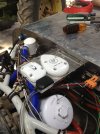1. Mount the antenna as close to level as possible with respect to the normal cruise flight attitude of
the aircraft. If the normal flight attitude is not known, substitute with the waterline, which is
typically referenced as level while performing a weight and balance check. A shim may be used
to level the antenna.
2. The GPS antenna should be mounted in a location to minimize the effects of airframe shadowing
during typical maneuvers. Typically mounting farther away from the tail section reduces signal
blockage seen by the GPS antenna.
a) The GPS antenna should be mounted no closer than two feet from any VHF COM antenna or
any other antenna which may emit harmonic interference at the L1 frequency of 1575.42
MHz An aircraft EMC check (See Section 5.10.3) can verify the degradation of GPS in the
presence of interference signals. If an EMC check reveals unacceptable interference, either
insert a GPS notch filter in line with the offending VHF COM or the (re-radiating) ELT
transmitter, or select a different GPS antenna location.
b) The GPS/WAAS antenna should be mounted no closer than two feet from any antennas
emitting more than 25 watts of power. An aircraft EMC check can verify the degradation of
GPS in the presence of interference signals.
c) To minimize the effects of shadowing at 5 elevation angles, the GPS/WAAS antenna must
be mounted no closer than 9 inches (center to center) from other antennas, including passive
antennas such as another GPS antenna or XM antenna.
3. To maintain a constant gain pattern and limit degradation by the windscreen, avoid mounting the
antenna closer than 3 inches from the windscreen.
4. For multiple GPS installations, the antennas should not be mounted in a straight line from the
front to the rear of the fuselage, to prevent lightning damage to both antennas in the case of a
lightning strike. Also varying the mounting location will help minimize any aircraft shading by
the wings or tail section (in a particular azimuth, when one antenna is blocked the other antenna
may have a clear view).
A 12 inch center-to-center spacing between GPS antennas is required to achieve the best possible lowelevation
antenna gain by minimizing pattern degradation due to shadowing and near-field interaction.
When practical, 12 inch center-to-center spacing between GPS antennas must be used. If 12 inch spacing
is not practical, the maximum center-to-center spacing possible must be used, but never less than 9 inch
center-to-center spacing. Spacing less than 9 inches center-to-center results in unacceptable antenna
pattern degradation.

